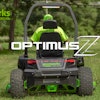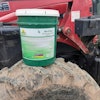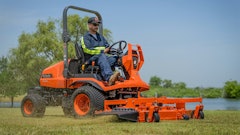
Spring is in the air, so it's time to gear up for a busy land clearing season. As you shift from snow clearing to mowing and mulching tasks, ensuring your equipment is in top shape is essential. Following are tips to make sure your attachments and carrier are ready for peak performance.
Attachment Maintenance
Equipment downtime is the bane of most contractors, negatively impacting productivity and profitability. To avoid disruptions and delays, it’s essential to maintain and stock up on those parts that take the greatest abuse to minimize downtime and avoid operational interruptions.
- Mulching and Stump Grinder Teeth: Teeth are one of the hardest working components of any attachment and may need to be replaced multiple times throughout a season depending on equipment use. These parts are subject to constant wear from processing vegetation and direct ground engagement, so it is crucial to maintain and replace them. Some steel teeth can be removed and sharpened, or rotated directly on a mulching attachment, to increase efficiency and productivity.
- Flail Knives and Rotary Blades: If you own a flail mower, rotary mower, or brush cutter, maintaining blades is critical for optimal performance and longevity. Inspect flail knives and blades before each use, looking for signs of wear, damage, or debris that may be stuck. If you notice any significant damage, such as bends or cracks, it’s time to replace them.
- Hydraulic Connections: Inspect hoses, connections, and couplers before each use. Tighten any loose connections and replace any damaged or worn parts.
- Mounting Hardware: Check all mounting hardware for correct torque values. If any are loose, re-torque them to their proper specifications, and replace those that are worn or broken.
- Spindles: Replace oil and grease in spindles every 500 hours or yearly. Make sure all spindle bolts feature the correct torque values and re-torque them if needed.
Carrier Maintenance
Because dirt and grime can damage components, a simple cleaning of both the interior and exterior of your carrier will go a long way to ensuring your equipment is ready for the busy season ahead.
- Clean Your Equipment: A thorough wash to remove dirt and debris will help keep your equipment in excellent shape. Pay special attention to the undercarriage and control systems for any clutter left over from the previous season.
- Perform Maintenance Checks: After months of sitting idle, it is important to conduct a thorough inspection of all filters, fluids, and coolant levels, and to lubricate all machine components. Refer to your operator’s manual for specific instructions for your carrier.
- Check Batteries and Electrical Components: Test the battery and verify that electrical elements like lights, wipers, and flashers are working correctly. Ensure a secure connection and sufficient charge.
- Test Primary Functions: After performing maintenance work, ensure steering controls, parking brakes, safety features, and horns are all operational. Any abnormalities should be addressed promptly.
Conduct a Comprehensive Inspection
Once your equipment is clean and functioning properly, perform a walk-around inspection to check the following components:
- Lights, Reflectors, Tires and Tracks: Check for damage and ensure proper tension, pressure, and cleanliness on all lamps, lenses, tires, and tracks. Well-maintained tires and tracks are also essential for fuel efficiency and a smooth ride.
- Windshields and Glass: Keep these surfaces clean to ensure complete visibility during operation. Stock up on safety glass as needed according to manufacturer specifications.
- Hydraulic Hoses: Look for signs of wear or damage in hydraulic hoses and replace them if necessary.





















